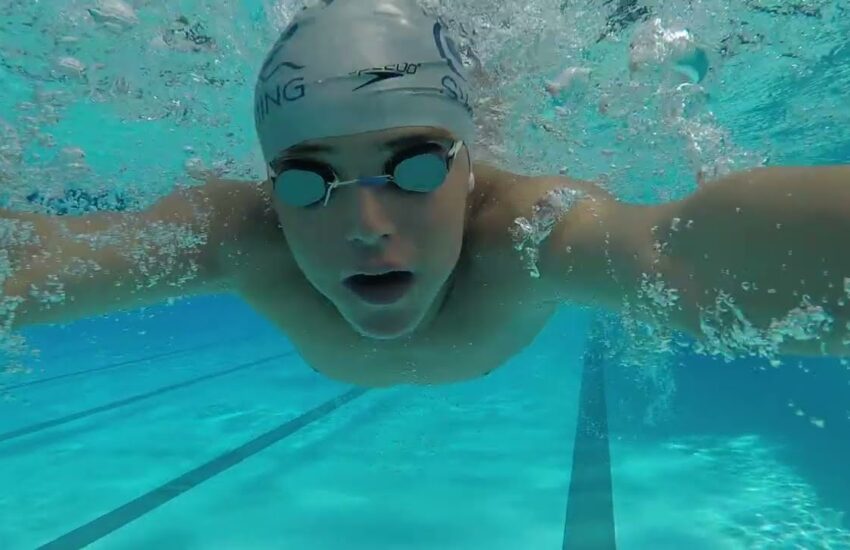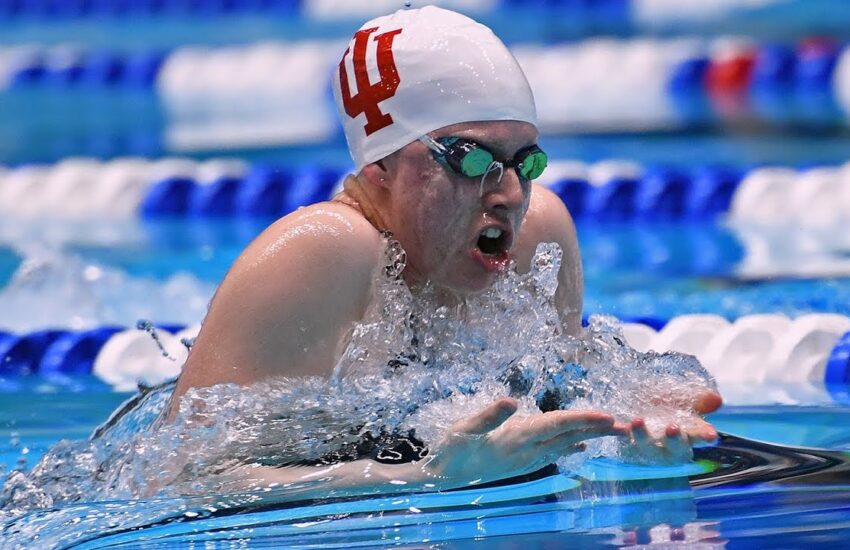How to breathe while swimming?
The best technique for breathing while swimming is to focus on alternating between the nose and mouth. Two common ways to breathe while swimming are bilateral breathing and single-side breathing. While single-side breathing means choosing only one side to breathe, bilateral breathing involves alternately breathing from both sides. Each stroke has its own proper breathing technique, so it’s best to focus on one that works best for you. This technique applies to each stroke and is the same no matter how you swim, so it’s important to learn the correct one for each.
Exhalation just before and while the head is turning or elevating for the next breath
Great swimmers will release air through the nose, much like blowing bubbles as a child. The air bubbles will move under the body and rise to the surface before the head turns and the next breath is drawn. The rest of the exhalation occurs just before the head turns for the next breath. Swimming techniques for exhalation will vary among swimmers, so you may need to experiment a little before you find the most efficient method for you.
The breathing stroke cycle is very similar to the non-breathing cycle, so be patient as you learn to breathe. The key to achieving this technique is to rotate the head enough to position the mouth above the surface, while maintaining the streamline position. Some new swimmers try to elevate their head before taking a breath by rotating their neck and face up, which causes the rest of the body to move out of place.
Breathing efficiently is a key component to technical swimming. It can also affect your mental state and the way you move in the water. Exhaling too slowly or too long may result in panic breathing and a tightened chest. Furthermore, long breaths can result in lightheadedness and a tight chest. Another mistake is lifting the head too high during the swim, which may lead to inefficient body positioning, leg drop and unnecessary neck strain.
This technique is vital for effective swimming. Many swimmers struggle to hold a low breathing position when they are underwater. Besides that, they have a very short window for breathing during this crucial phase of the stroke. If you are able to manage the amount of time your face is out of the water during the next stroke, it will help prevent you from feeling winded and unable to finish the next stroke.
Exhalation forcefully through nose and mouth to reduce CO2 buildup
Holding your breath while swimming increases the amount of CO2 in your system. Excessive CO2 buildup can cause a blackout or distressing out-of-breath urge. Controlling your exhalation will reduce CO2 buildup in your system, allowing you to complete more strokes between breaths. Here are three benefits of controlling your exhalation:
The first benefit of exhalation through your mouth and nose while swimming is that you are able to get rid of the CO2 you produce by inhaling forcefully. As you inhale, you should see a continuous stream of bubbles and try to exhale forcefully through your mouth and nose. This way, you will eliminate excess CO2 that builds up in your lungs and make you feel more fatigued.
Second, exhalation is essential for good breathing. Inhalation on land and breathing during exercise is natural. But while swimming, you need to be more deliberate about your breathing. You will find that you can breathe more effectively if you exhale forcefully through your nose and mouth. As a result, your lungs will be able to handle more air, thus allowing you to swim faster.
Butterfly breathing technique
A butterfly is a type of swimming in which the swimmer breathes from the front or side. The exact breathing technique depends on the strength of the swimmer. During butterfly swimming, it is important to breathe in when the body is the farthest out of the water and to exhale as the head dips back under the water. When performing this technique, it is also important to maintain the head facing downward and to keep the hands in line with the shoulders.
The butterfly swimming breathing technique requires inhalation during the upsweep and the recovery phase of the arms. The head must be elevated off the water. During the upsweep phase, the swimmer must look slightly forward. During the next arm cycle, the head remains face down. Inhalation helps in achieving a sustainable stroke. Beginners often make the common mistake of not breathing correctly. By practicing the butterfly breathing technique, you will be able to achieve an effective stroke and make it look effortless.
The breathing technique can be practiced during any length of swimming. During the initial stages of learning this style, swimmers should practice the technique by doing it three or four times over the course of 25 metres. Aside from kicking, swimming fins can also help in the process as they help in adding power. Once you learn the technique, you should practice it in the pool with swimming fins to make it easier for you. As you continue practicing, you will soon notice a marked improvement in your butterfly breathing technique.
Using this breathing technique while swimming helps in getting into a more streamlined position. Practice side breathing by kicking lightly to the side and keeping your spine straight while swimming. Also, try a one-arm fly drill. This is very similar to the butterfly stroke, except you don’t rotate your head on its axis during the recovery. This allows you to breathe more comfortably with your mouth. Once you learn the butterfly breathing technique, you can apply this technique to other swimming strokes, too.
Bilateral breathing
The use of bilateral breathing while swimming can have many benefits. One benefit of bilateral breathing is the control it provides. It allows swimmers to get more oxygen in their bodies and perform better with less. Another benefit is that swimmers who practice bilateral breathing are more likely to cope better with an oxygen shortage during a race. When you can control your intake, you can perform at your peak. So, what are the advantages of bilateral breathing while swimming?
First of all, it is important to practice your stroke with proper breathing techniques. When swimming, you need to breathe properly with each side. Try bob up and down, break the surface, and blow bubbles on both sides. When swimming, you should breathe slowly and consistently, and try to maintain a steady stream of bubbles. As you learn to breathe properly while swimming, you can then move on to the traditional bilateral breathing technique used during freestyle.
In addition to being more efficient and calmer, bilateral breathing improves the technique. Bilateral breathing improves the freestyle form, as it makes swimmers more visible and calmer. Additionally, it helps them see the other competitors and waves in the water more clearly. Most swimmers instinctively breathe to one side. But learning to breathe to the opposite side can be beneficial. If you’re not comfortable breathing into chop, practice using the opposite technique while swimming.
The benefits of bilateral breathing while swimming go beyond technique. In an emergency, bilateral breathing can save your life. It’s important to practice your swimming stroke while swimming in open water. Practice makes perfect, so it’s essential to make the time necessary to perfect it. You’ll soon notice a difference in your stroke and time in the water. So, practice makes perfect, so get going and get swimming! You’ll be glad you did!
One-arm drill to improve balance in the water
The one-arm drill is a useful exercise for improving single-arm efficiency and balance in the water. It focuses on the complete stroke, including the high-elbow recovery that sets the stage for a good underwater phase. In addition to this, it trains swimmers’ timing of breaths and rotations and increases their stroke efficiency. One-arm drills should be performed with the other arm at the side, and the nonworking arm should remain at the side.
Another exercise is the flutter kick, which can help increase balance in the water. It improves hip stability and technique. This exercise should be performed with the hands shoulder-width apart, while keeping the head above water. For a more advanced version of this drill, the swimmer should raise one arm above their head and cross it over their chest. This is an advanced exercise. For beginners, the exercise is simple: the swimmer should extend both arms to reach for the wall and keep one arm in the water while the other extends to grab a paddle. Then, the swimmer should recover their arms to their streamline position and repeat the exercise with the other arm.
A variation of this drill is the backstroke drill. When the opposite arm pulls, the shoulder on the inactive arm should emerge from the water. Then, the swimmer can repeat the drill with the other arm, switching sides after every three strokes. The inactive arm should remain at the side throughout the drill, to emphasize the full shoulder and hip rotation. There are also variations of the one-arm backstroke drill. A variation is to perform three strokes with the right arm out in front, and three strokes with the left arm. The inactive arm can also be moved up to 90 degrees on the opposite side.


